In 2021, I emailed 157 art-related items to my members of my free Sunday Recommendations list. (To join, just ask me: DuranteDianne@gmail.com.) For supporters, I recommended 52 more items. The items in this post and the posts from the last two weeks are my favorites among them. They include 12 items that were originally shared only with supporters, which are marked with two asterisks.
Architecture
- Borromini, Francesco. Dome of S. Ivo della Sapienza, Rome (1648). A stunning piece of Baroque architecture: two triangles superimposed, with alternating convex and concave surfaces. I need to visit this space!

Runners-up:
- Ryman, Herbert. Cinderella’s Castle, Disney World, Orlando (1971). Has it ever crossed your mind that someone had to design Cinderella’s Castle? It’s not a reproduction of a book illustration or of any particular European castle. The designer was Herbert Ryman (1910-1989). Ryman worked as an artist and illustrator for MGM (the Emerald City in the 1939 Wizard of Oz is his work) before being recruited by Walt Disney. At the Disney Studios, he was art director for Fantasia and Dumbo. After Ryman had some fascinating adventures elsewhere, Walt asked him back, in the 1950s, to produce concept sketches for a unique family park. When the funds had been raised for Disneyland, Ryman designed Main Street, U.S.A., and the Sleeping Beauty Castle. He contributed to the Jungle Cruise and Pirates of the Caribbean. And Ryman is credited as the chief designer of the Cinderella Castle at Disney World in Orlando. More on his sources (with photos) here.

- Weissenburger, Lucien, and Henri Sauvage. Villa Majorelle (1901-1902). There are certain lines and shapes that my eyes enjoy following, and the exterior of this mansion has a lot of them. (More photos here.) I’m judging it more as a piece of design than as architecture; I wouldn’t venture to judge it as a building without having moved through the interior, or at least seen many more photos of it than Trip Advisor has. The Villa was commissioned by Louis Majorelle, and was among the earliest and most influential examples of Art Nouveau architecture in France. Majorelle himself did much of its interior design. Majorelle also created the stained-glass steel-working windows at Longwy (see Decorative Arts, below).
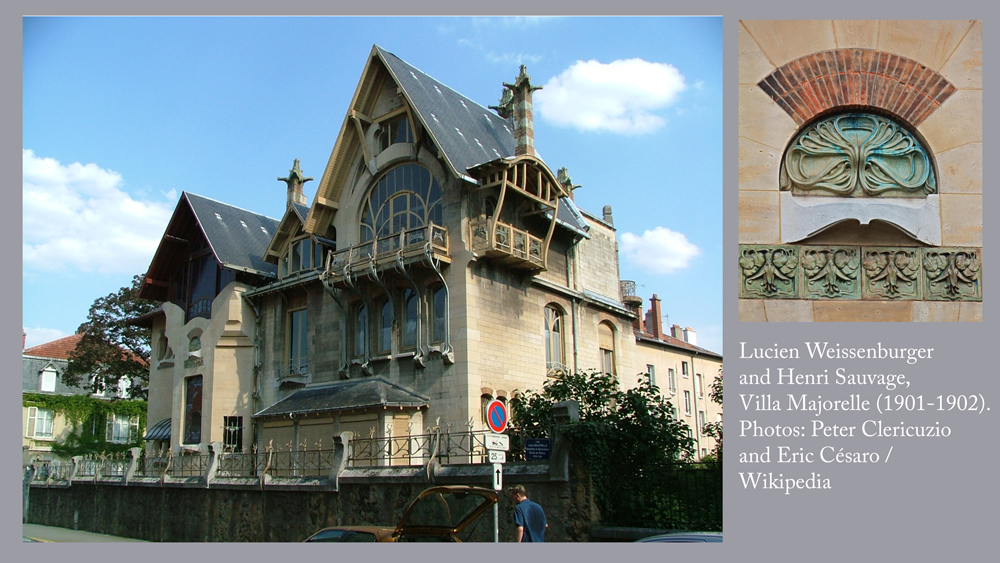
- ** Zaha Hadid Architects. Twin towers, part of Shenzhen Bay Super Headquarters Base business center (near Macau and Hong Kong) (2021+). The concept images are stunning. The project was just awarded early in 2021; I haven’t seen an estimated completion date. My first view of a building by Zaha Hadid (1950-2016) was 520 West 28th St. (visible from the High Line in New York City), which looks like a house the Jetsons would live in. These towers look like something George Jetson would work in.
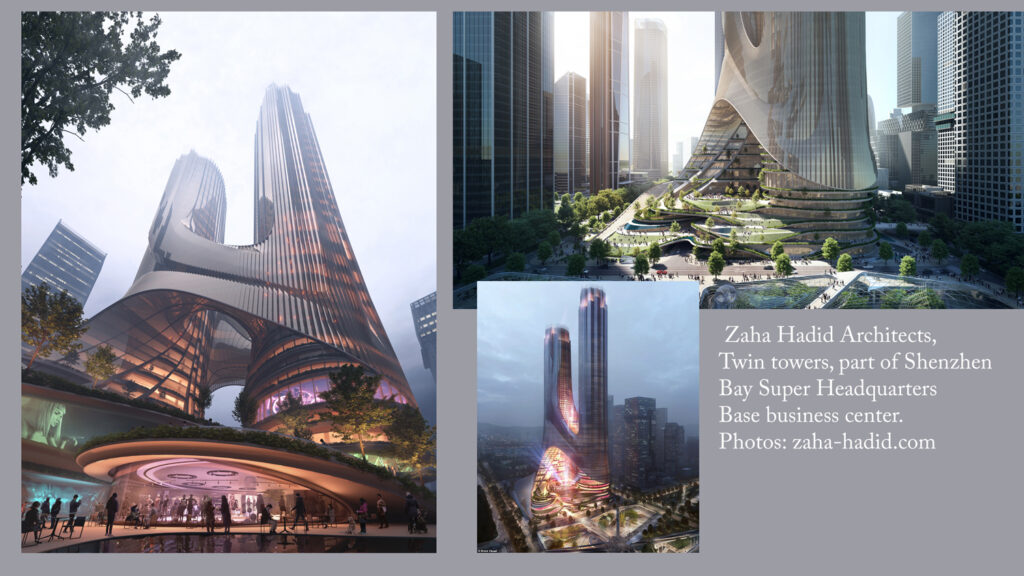
Decorative arts
Winner:
- Majorelle, Louis. Stained glass windows for the Longwy Steelworks (1926-1928): click here and scroll to the gallery at the end of the article; shown in situ here. These 27 glorious Art Deco windows show the steel-making process in the 1920s. They were designed for the Aciéries de Longwy in Longwy, France (near the Luxembourg-Belgium border), by Louis Majorelle (1859-1926). His workshop completed them in 1928. They now are on view in the Maison de la Formation de Longlaville. Majorelle trained in Paris with Naturalist painter Jean-François Millet. Returning to Nancy after his father’s death in 1879, he applied his talents in the visual arts to the family’s furniture manufacturing firm. In the 1890s he became a prominent designer in the Art Nouveau style, helping make Nancy one of the European centers of that style.

Runners-up:
- ** Zapf, Hermann. Zapfino (font) (1944-1998 and later). Sometimes decorative art makes your life beautiful in ways you’d never expect. If you’ve received any upscale decorative notifications in the past twenty-odd years, you’ve almost certainly seen the elegant, swirling Zapfino font – even though you might not know its name. Hermann Zapf created Zapfino in 1944 with pen and ink. It couldn’t be used widely in print typography until 1998, when adaptation for computers allowed precise spacing. It’s beautiful for headlines, although I’d never use it for text. Zapf (1918-2015) was also responsible for the popular Palatino and Optima fonts, and for Zapf Dingbats. See him in action in this video produced by Hallmark, who asked him to lecture to their calligraphers. For his own bio, told in terms of his font designs, see here. For more examples of his calligraphy and print design, see this tribute.
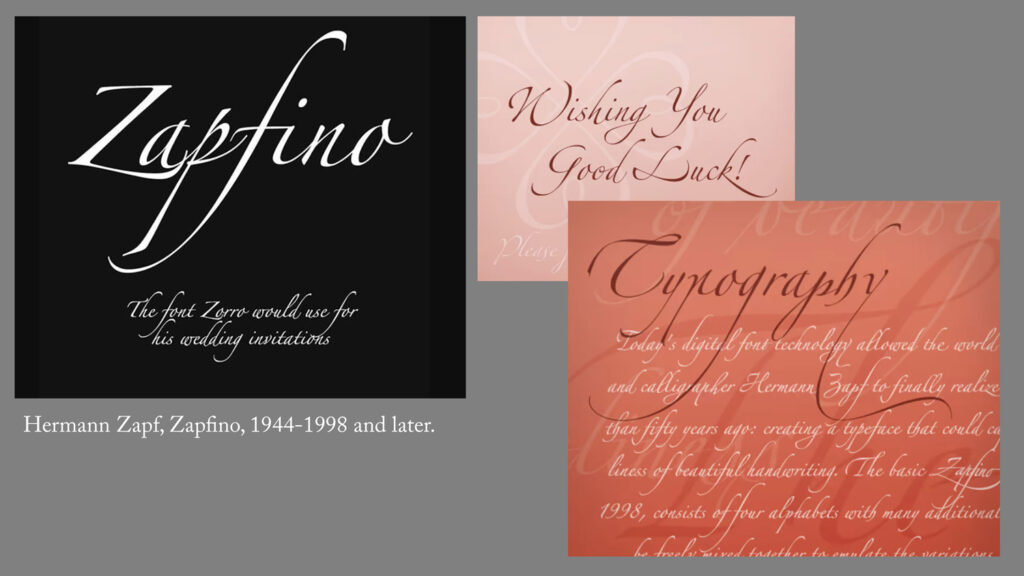
- Gate of the Villa Knopf (1904-1905). For contrast with The Breakers: the Art Nouveau gate of a mansion in Strasbourg, France, which was completed barely ten years later. More images of Villa Knopf here.
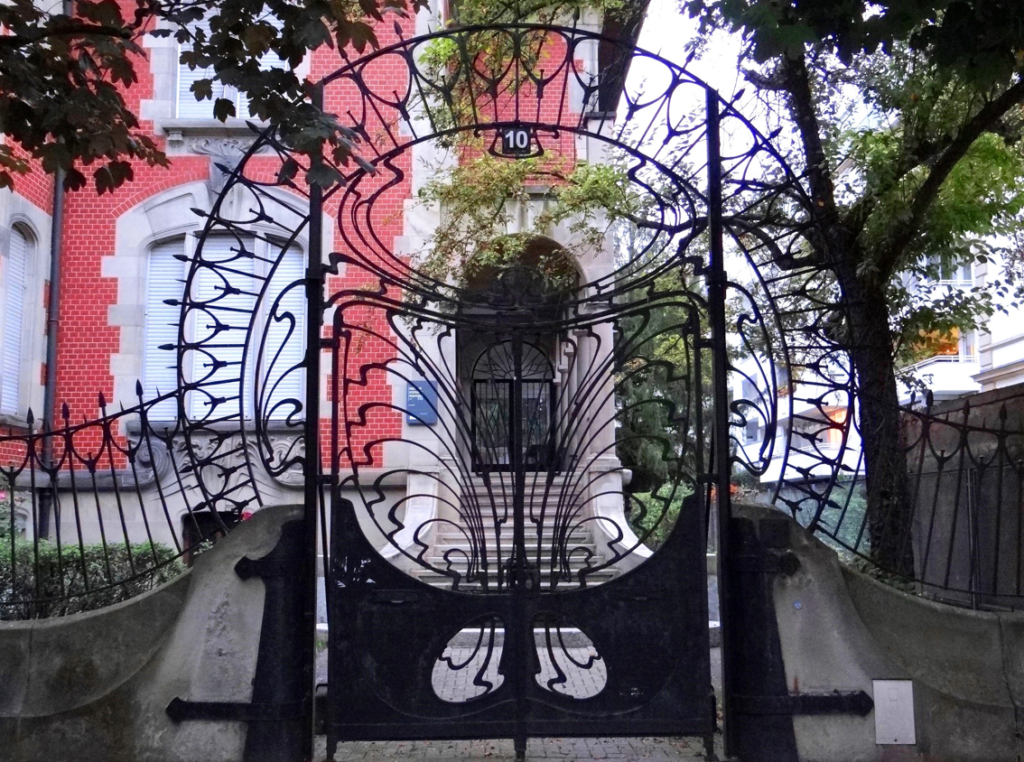
Music: classical
Winners (another tie):
- The Beethoven Project – Paavo Járvi in Bremen (part 1, part 2, part 3, part 4) (2013). Fascinating insights into Beethoven’s symphonies via interviews with Paavo Járvi, conductor, and members of the Deutsche Kammerphilharmonie Bremen, as they rehearse to perform of all nine of the symphonies within a few days. Each of the four parts is about 25 minutes long. HT Teresa H.
- Joplin, Scott. “Magnetic Rag” (1914). This is the last rag Joplin (ca. 1868-1917) published in his lifetime, and one of my favorites to play, for the melodies and the sheer buoyant energy. I’ve linked to the version played by Joshua Rifkin, one of the great interpreters of Joplin. Rifkin’s three albums of Joplin rags were largely responsible for the revival of interest in the composer in the 1970s. (I’m torn between putting this under classical or pop.)
Runner-up:
- Berlioz, Hector. Orchestration of the “Rákóczi March” (1846). The late 1840s saw uprisings against monarchical governments throughout Europe. For a concert appearance in Budapest, Berlioz orchestrated a version of a popular Hungarian folk tune associated with an eighteenth-century rebellion against the Habsburgs. In his memoirs Berlioz recalled, “The hall was shaken by unprecedented shouting and stamping of feet. … We had to start again but on the second occasion, too, the audience could hardly or not at all control themselves, just like on the first occasion.” In 1851-1853, Franz Liszt used the same tune for his Hungarian Rhapsody No. 15 (here with music, here with a pianist). HT Heather MacDonald in “Classical Music Under Racial Attack” (part 1, part 2), which is well worth reading if you have any interest in classical music or, indeed, in any of the arts.
Music: pop
Winner:
- ** Nek. “Viviré“, from La Vida Es (2000). Listening to pop music in a foreign language makes me slow down and pay attention to word order, word choice, and sounds in a way I don’t when listening to pop music in English. The energy level on this song says (like the words): “I will not give up!” Perhaps because Nek was born Italian, his Spanish pronunciation is beautifully precise. If you know even a smattering of the language, you’ll probably be able to follow along with the lyrics. Email me if you want a copy of the song and my translation (accurate but not beautiful): DuranteDianne@gmail.com.
Runners-up:
- ** Burnham, Bo. “Welcome to the Internet” (2021). Brilliantly concretized and eerily addictive, as the Net is for many people. Includes some crude language. The song is from the album Inside, which was written, directed, performed (all roles), and edited during the Covid-19 pandemic by Bo Burnham (b. 1990). HT Allegra D. & Dylan A.
Could I interest you in everything all of the time?
A little bit of everything all of the time
Apathy’s a tragedy, and boredom is a crime
Anything and everything all of the time …
Shelton, Blake, and Gwen Stefani. “Nobody But You” (2020). A Valentine’s Day recommendation. As with many pop songs, I agree with some but not all of the sentiments … but I do like the passion.
Morricone, Ennio. Theme from The Good, the Bad, and the Ugly, performed by the Danish National Symphony Orchestra and Concert Choir (2018). Watch it while you listen. HT Earl G.
Mraz, Jason, and Colbie Caillat. “Lucky” (2009). One of my favorite romantic pop songs. The video is unexpectedly classy, and I love the way the singers’ voices harmonize.
Dance
Winner:
- Top 10 tap-dancers (video compiled by Terry Swoope). For Ayn Rand’s birthday: a video of ten superb tap dancers. Until I watched these performers in a sequence, I hadn’t noticed how much posture varies among performers. Savion Glover (#10) has great footwork but seems to always be looking down, while the Nicholas Brothers (#1) are always dancing tall.
Runner-up:
- Hough, Derek, and Laura Osnes. “Put on a Happy Face” (2021). Hough’s dancing style is much more fluid than Van Dyke’s, but incorporates many of the distinctive gestures from Van Dyke’s “Happy Face”. Hough, who first made a name on Dancing with the Stars, performed this tribute at the 43rd Annual Kennedy Center Honors: Dick Van Dyke. HT Sam Axton on Facebook.
Movies
Winner:
- The Greatest Showman (2017). Not what I expected in a movie about P.T. Barnum! The emphasis is on learning to have confidence in yourself and achieving your goals. The style and mood are similar to Rocketman (2019): a high energy level with wonderful music, singing, and dancing, plus some spectacular acrobatics. I’ll certainly watch it again, which isn’t true of many modern movies. I missed this in theaters, and was only aware of it from a Bloomingdale’s Christmas window in 2017 (scroll to the last photo), which had a P.T. Barnum quote beneath: “No one ever made a difference by being like everyone else.” The complete soundtrack is available on YouTube; lyrics here. HT Tim Chermak in The Objective Standard for his recommendation of the trailer and the movie.
Runners-up:
- Guess Who’s Coming to Dinner? (1967). Sidney Poitier, Spencer Tracy, Katharine Hepburn. A look at race, love, and parenthood, in the form of a well-acted drama rather than a polemic. How had I never seen this movie before? HT John P. on Facebook.
- Vitus (2006). Another movie about making your dreams come true. The hero is a prodigy on the piano and exceptionally intelligent, but has a domineering mother. I can’t think of anything else to say that wouldn’t spoil some of the fun … except that I don’t think you will guess how he deals with the problem.
- Nobody (2021). Action-adventure, with a fair amount of gore … but also a very likable main character who acts with purpose. It makes me think of Liam Neeson’s movies, but with a wonderfully appropriate soundtrack and a fair amount of humor (not mocking or campy). Bob Oudenkirk, the lead, wrote in the 1980s-1990s for Saturday Night Live and the Dennis Miller, Ben Stiller, and Conan O’Brian shows. The man can do comedy.
TV
Tied for winner:
- Crash Landing on You (2019-2020). A Netflix show from South Korea, the country that also gave us Dae Jang Geum. Premise: a young South Korean businesswoman who’s para-gliding is swept into North Korea by a storm and has to struggle to escape, with the help of a soldier who’s the son of a high-ranking North Korean politician. It’s a very enjoyable miniseries, with romance and suspense. Few things have made me so happy to be an American as seeing this film’s depiction of North Korea, contrasted with capitalist South Korea. HT Adam R.
- Queen’s Gambit (Netflix series) (2020). In case you missed the buzz and need something to binge-watch: a seven-episode series about a chess champion. I’d never heard of her, so I had no idea how the story would end: and that was a good thing. You don’t need to know chess to enjoy the series. Deals with friendship, learning (by oneself or from others), and surviving setbacks (quite a few of them). Great acting and cinematography, including dramatizations of chess matches. The soundtrack by Carlos Rafael Rivera (available on YouTube) captures the dramatic, suspenseful mood. The hit song from the series (who’d have thought a series on chess would have a hit song?) is “I Can’t Remember Love”: video here, interview with the songwriter / singer here. HT Eric Kalin for the links to the soundtrack and song.
- The Paradise (BBC) (2012). Set ca. 1870 in an early department store: romance, intrigue, and inventive marketing. Via Amazon Prime, 2 seasons, 8 episodes each. HT Tom B on Facebook.
More
- In 2021 I published The Financial Programs of Alexander Hamilton, by a Farmer’s Daughter: a massive amount of research and writing, but I’m very glad I did it, and happy that it has received such positive comments.
- Also out this year: the last two volumes of my edition of Henry Kitchell Webster’s Collected Short Works and Related Correspondence (vol. 3, 1915-1922, and vol. 4, 1922-1932).
- For more of my writings, see the Books and Essays page. All my books are available in Kindle and/or print format via my Amazon author page. And check out dozens of videos from 2021 on my YouTube channel.
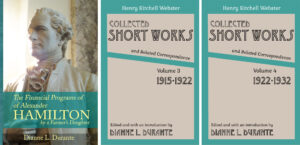
- For favorites from earlier years, see the Favorite Recommendations and Photos link.
- Want wonderful art such as these recommendations delivered weekly to your inbox? Check out my free Sunday Recommendations list and rewards for recurring support: details here.
